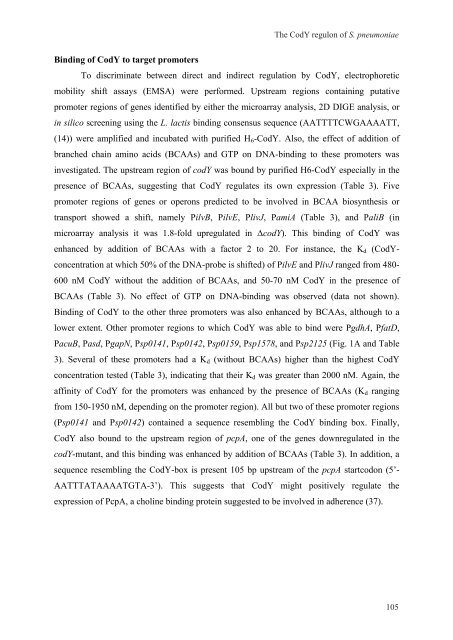Gene regulation in Streptococcus pneumoniae - RePub - Erasmus ...
Gene regulation in Streptococcus pneumoniae - RePub - Erasmus ...
Gene regulation in Streptococcus pneumoniae - RePub - Erasmus ...
You also want an ePaper? Increase the reach of your titles
YUMPU automatically turns print PDFs into web optimized ePapers that Google loves.
B<strong>in</strong>d<strong>in</strong>g of CodY to target promoters<br />
The CodY regulon of S. <strong>pneumoniae</strong><br />
To discrim<strong>in</strong>ate between direct and <strong>in</strong>direct <strong>regulation</strong> by CodY, electrophoretic<br />
mobility shift assays (EMSA) were performed. Upstream regions conta<strong>in</strong><strong>in</strong>g putative<br />
promoter regions of genes identified by either the microarray analysis, 2D DIGE analysis, or<br />
<strong>in</strong> silico screen<strong>in</strong>g us<strong>in</strong>g the L. lactis b<strong>in</strong>d<strong>in</strong>g consensus sequence (AATTTTCWGAAAATT,<br />
(14)) were amplified and <strong>in</strong>cubated with purified H6-CodY. Also, the effect of addition of<br />
branched cha<strong>in</strong> am<strong>in</strong>o acids (BCAAs) and GTP on DNA-b<strong>in</strong>d<strong>in</strong>g to these promoters was<br />
<strong>in</strong>vestigated. The upstream region of codY was bound by purified H6-CodY especially <strong>in</strong> the<br />
presence of BCAAs, suggest<strong>in</strong>g that CodY regulates its own expression (Table 3). Five<br />
promoter regions of genes or operons predicted to be <strong>in</strong>volved <strong>in</strong> BCAA biosynthesis or<br />
transport showed a shift, namely PilvB, PilvE, PlivJ, PamiA (Table 3), and PaliB (<strong>in</strong><br />
microarray analysis it was 1.8-fold upregulated <strong>in</strong> ΔcodY). This b<strong>in</strong>d<strong>in</strong>g of CodY was<br />
enhanced by addition of BCAAs with a factor 2 to 20. For <strong>in</strong>stance, the Kd (CodY-<br />
concentration at which 50% of the DNA-probe is shifted) of PilvE and PlivJ ranged from 480-<br />
600 nM CodY without the addition of BCAAs, and 50-70 nM CodY <strong>in</strong> the presence of<br />
BCAAs (Table 3). No effect of GTP on DNA-b<strong>in</strong>d<strong>in</strong>g was observed (data not shown).<br />
B<strong>in</strong>d<strong>in</strong>g of CodY to the other three promoters was also enhanced by BCAAs, although to a<br />
lower extent. Other promoter regions to which CodY was able to b<strong>in</strong>d were PgdhA, PfatD,<br />
PacuB, Pasd, PgapN, Psp0141, Psp0142, Psp0159, Psp1578, and Psp2125 (Fig. 1A and Table<br />
3). Several of these promoters had a Kd (without BCAAs) higher than the highest CodY<br />
concentration tested (Table 3), <strong>in</strong>dicat<strong>in</strong>g that their Kd was greater than 2000 nM. Aga<strong>in</strong>, the<br />
aff<strong>in</strong>ity of CodY for the promoters was enhanced by the presence of BCAAs (Kd rang<strong>in</strong>g<br />
from 150-1950 nM, depend<strong>in</strong>g on the promoter region). All but two of these promoter regions<br />
(Psp0141 and Psp0142) conta<strong>in</strong>ed a sequence resembl<strong>in</strong>g the CodY b<strong>in</strong>d<strong>in</strong>g box. F<strong>in</strong>ally,<br />
CodY also bound to the upstream region of pcpA, one of the genes downregulated <strong>in</strong> the<br />
codY-mutant, and this b<strong>in</strong>d<strong>in</strong>g was enhanced by addition of BCAAs (Table 3). In addition, a<br />
sequence resembl<strong>in</strong>g the CodY-box is present 105 bp upstream of the pcpA startcodon (5’-<br />
AATTTATAAAATGTA-3’). This suggests that CodY might positively regulate the<br />
expression of PcpA, a chol<strong>in</strong>e b<strong>in</strong>d<strong>in</strong>g prote<strong>in</strong> suggested to be <strong>in</strong>volved <strong>in</strong> adherence (37).<br />
105<br />
105

















